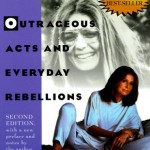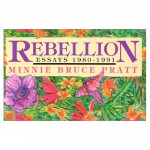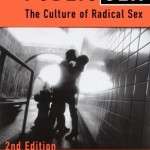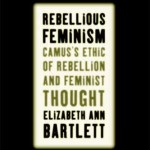I was in the process of cleaning my home office when I realized that maybe, just maybe, having 57 books (and more coming soon, including Queer Optimism) checked out of the U’s library is too many–especially since I have had some of those books for a couple of years. Yikes. So, in the interest of cataloging some of the important parts of these many books so that I can return them, I offer this post on the rebel and rebellion.
 OUTRAGEOUS ACTS AND EVERYDAY REBELLIONS
OUTRAGEOUS ACTS AND EVERYDAY REBELLIONS
by Gloria Steinem
This is an edited collection of Steinem’s greatest hits from the 1970s and 80s. I picked it up over a year ago because I was interested in what she might have to say about the rebel and rebellion as a concept and a practice. Having skimmed the introduction (finally), I am happy to return it. I was hoping for a more substantial fleshing out of what is meant by everyday rebellion and outrageous acts than Steinem offers. Instead she provides a narrative of her own experiences as a writer, engaged in the rebellious practice of speaking her mind–and writing about it too! I have nothing against Steinem, I just don’t find her description (or lack thereof) of rebellion to be very compelling or thought-provoking.
 REBELLIONS: ESSAYS 1980-1991
REBELLIONS: ESSAYS 1980-1991
by Minnie Bruce Pratt
Before skimming this book there were three things that I knew about Minnie Bruce Pratt. First, she wrote a highly influential essay, “Identity: Skin Blood Heart,” that served as the inspiration for Chandra Mohanty and Biddy Martin in their article, “What’s Home Got to Do With It?” I read this article as part of my masters’ research on identity politics in 1997/98. Sadly, I have yet (over 10 years later) to read Pratt’s essay in its entirety. Second, Pratt is one of several (Dorothy Allison and Mab Segrest are two other important ones) Southern white lesbian writer-activists who reflect on their intersecting experiences as white, Southern, female, feminist and lesbian. Third, Pratt is partners with another highly influential writer/activist within the worlds of gender studies, Leslie Feinberg. But, enough of that trivia. Back to the book. The first essay in this collection is “Rebellion” and in it Pratt does a much better job than Steinem in fleshing out exactly what rebellion is to her. Pratt places her experiences growing up in a very racist Southern community at the center of her coming-to-consciousness as a rebel. Here is how Pratt defines (and practices) rebellion:
when we speak, say certain things, certain words, we rebel; we put ourselves outside manners and civilization; we step over a boundary into the forbidden (24).
This speaking and saying certain words that are not supposed to be said is what Pratt practices through her writing and her everyday engagements with others (hmm….is this what Steinem was getting at with the everyday rebellions of her title?). She is a self-proclaimed rebel. But, as the final passage of her first essay suggests, she did not name her collected essays solely after herself and her own activism. She writes,
I begin to understand that a white woman of the South can live and write, but not of the dead heroes. She can live and write a new kind of honor, the daily, conscious actions of women in true rebellion (25).
Nice. I think I will have to keep this book for a little while longer. Or, maybe I should just buy it..
 “INTRODUCTION: OR IT IS ALWAYS RIGHT TO REBEL” from PUBLIC SEX
“INTRODUCTION: OR IT IS ALWAYS RIGHT TO REBEL” from PUBLIC SEX
by Pat Califia
I think I picked up this book from the library in preparation for my Introduction to GLBT Studies course in the fall of 2008. I didn’t use any essays from it then and I probably won’t use anything from it this fall in Queering Theory. As I was scanning it earlier today I came across the introduction (which is always my favorite part of the book. Is that wrong? I like conclusions too!) and decided to throw it into the mix here. Slowly but surely I am learning more about the 70s/80s epic battle between anti-porn feminists like Dworkin and Mackinnon and pro-sex feminists like Gayle Rubin and Pat Califia. But that’s not why I had checked this book out. Pat, now Patrick, wrote a compelling piece entitled “Manliness” that is included in the Transgender Studies Reader. I had my students read it last fall and they really liked it.
But, I digress. Back to the introduction from Public Sex. For Califia, to rebel is to be a sex radical or someone who is not only deviant but defiant. The sex radical as rebel is
aware that there is something unsatisfying and dishonest about the way sex is talked about (or hidden) in daily life. [They] question they way our society assigns privilege based on adherence to its moral codes, and in fact, makes every sexual choice a matter of morality (11).
Here we go again. Morality is bad, as in repressive and prudish. Does Califia feel the same way about ethics? Is it possible to envision and construct morality (sexual morality) and/or ethics outside of the Moral Majority? Obviously Califia doesn’t think so. I will have to read more of this book to determine whether he believes that rebellion is always rebelling against ethics/morality and about being “bad.”
His reduction of morality to conservative and repressive thinking aside, I do like this introduction. Much like Steinem and Pratt, Califia places his discussion of rebellion in the context of his own experiences within feminism and the sex radical movement. I really like the conclusion to his section on what he left out of the book and that still needs to be done (and written about):
But this and other topics will have to wait for another book. I can’t imagine that there won’t be another book, just as I once couldn’t imagine living past thirty. Today, at the amazing age of forty, I am trying to cause just as much trouble as I did when I was twenty-five. Fifty should be awesome, and sixty incendiary (26).
Not only does he link rebellion with making trouble, but he envisions troublemaking as something sustainable–something to develop, maintain and promote throughout his life. Makes me think of Bernice Johnson Reagon’s fabulous essay “Coalition Politics: Turning the Century” and her emphasis on politics as learning how to survive and continue to do important political work throughout your life.
 REBELLIOUS FEMINISM: CAMUS’S ETHIC OF REBELLION AND FEMINIST THOUGHT
REBELLIOUS FEMINISM: CAMUS’S ETHIC OF REBELLION AND FEMINIST THOUGHT
by Elizabeth Ann Bartlett
Isn’t this title great? When I first found it online a few years ago, I was very excited. I should have bought this book in 2007, but it is really expensive–especially considering how small it is ($85 for 255 pages!), and my frugality won out over my desire to write in the margins. In this book (which I still need to read closely–and beyond the introduction), Bartlett suggests that there are some important connections to be made between Albert Camus’s work (especially in The Rebel) and feminist theory/activism. The book is organized around four core ideas that are fundamental to rebellion (and that are fleshed out by Camus and a wide range of feminist thinkers): 1. rejection of oppression and affirmation of dignity; 2. solidarity; 3. friendship and the primacy of concrete relationships; and 4. the valuing of immanence (5). I like Bartlett’s complex vision of rebellion, and her extension of it beyond the classic equation of rebellion = refusal or rejection. I also like her final chapter (yep, you guessed it–the conclusion!) on “A Politics of Limits and Healing.” Healing and limits are two themes that keep coming up in my work. I will have to let you know how Bartlett connects them and what she has to say about their value. Okay, here’s a teaser: she works through her ideas with the help of bell hooks and Audre Lorde (among others).
So, there you have it. But wait. While this lit review has helped me to catalog some important ideas from these books, it hasn’t helped encourage me to return them. It looks like I only plan to return the Steinem, but read more in the Pratt, Califia and Bartlett. Oh well. 1 down 56 to go.




